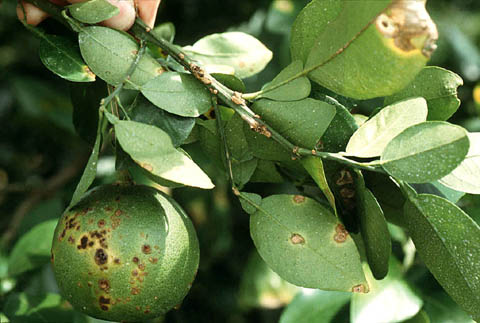Xanthomonas citri
Classification
Higher order taxa
Bacteria; Proteobacteria; Gammaproteobacteria; Xanthomonadales; Xanthomonadanceae
Species
Xanthomonas citri
|
NCBI: Taxonomy |
Description and significance
Xanthomonas citri is part of the Xanthomonas genus of phytopathogenic bacteria that inhabit the phyllosphere of citrus plants species and crops and produce the citrus canker disease. The bacteria is named for their pathogenic behaviors that target citrus fruits and crops. At least three forms of the disease exists, with one of them, Canker A, being the most destructive form.
Although the geographical origin and the original discoverer of X. citri is debatable; Lee (1918) stated that the species originated from southern China, however, Fawcett and Jenkins (1933) reported that the species originated from parts of India and Java. Fawcett and Jenkins’ findings suggest that X. citri originated from tropical areas in Asia. X. citri was first described in 1915, after it was found in the Gulf States of USA [3]. Severe infectious forms of the disease can cause premature fruit drop, defoliation, blemished fruit, and reduced fruit quality. In addition, warm, humid, or cloudy climate combined with heavy rainfall and strong wind exacerbates the impacts of the disease.
X. citri can also produce biofilms on both biotic and abiotic surfaces of organisms, particularly on cankers of diseased plants. The bacteria utilize flagella-mediated motility throughout biofilm formation, and sliding and swimming motility (without flagella) through diffusible signal factor (DSF) [5]. In addition, X. citri utilizes type IV pilus for twitching motility, biofilm development, and adherence [4]. X. citri secretes proteins through the type III secretory system into the extracellular matrix [6]. The bacteria are Gram-negative, rod-shaped, aerobic [2], and nonsporeforming, and also produces yellow, water-insoluble pigments due to the presence of carotenoid nostoxanthin and oxidatively metabolizes sugars [1].
Genome and genetics
a. To what major branch of the prokaryotes do they belong? (see textbook or Bergey’s). List 2-3 closely related but separate species or genera of bacteria.
b. Briefly describe any extra-chromosomal elements or genetic tools that are used to study the bacterium: viruses, plasmids, transposons that allow genetic manipulation and analysis.
c. Has the genome or genomes been sequenced? If so, include the website for the database and one or two highlights of the genome. Also indicate genome size (base pairs), %G+C (nucleotide base composition) and number of genes, and specific genes or gene regions that are unique to this organism. If it has not been sequenced, give its closest relative that has been sequenced, its website, and some general information about the related sequence.
Example: The sequence of Haemophilus influenzae was determined using whole genome shotgun sequencing (Fleischmann et al. 1995).
Nutrition and metabolism
a.Describe the growth characteristics of your bacterial species; sources of C, N, electrons; respires/ferments, uses O2, etc.
b.What kinds of culture conditions (temp, pH, media) are needed for laboratory study?
c.What kinds of waste, by-products, volatile compounds are generated?
Ecology / Pathology
Ecology: How is your microorganism important in the ecosystem where it is found? How does it impact other organisms in the environment (could be positive or negative impact)?
Pathology: How does the microbe cause disease as it interacts with the host? Describe any specific toxins or pathways that are used for invading and causing disease in the host. What treatment is used to inhibit or kill the microbe?
"X. citri" infected fruit, foliage, and stems from The American Phytopathological Society. http://www.apsnet.org/edcenter/intropp/lessons/prokaryotes/Pages/CitrusCanker.aspx
"X. citri" leaf lesions start as pinpoint spots and attain a maximum size of 2 to 10 mm diameter, from The American Phytopathological Society.http://www.apsnet.org/edcenter/intropp/lessons/prokaryotes/Pages/CitrusCanker.aspx
Current Research
In one recent study, scientists framed their research based on the idea that biofilm formation is important during early infection of Xanthomonas citri on host leaves. They focused on testing their hypothesis that small molecules that inhibit biofilm formation of X. citri would enhance control of the citrus disease. Through their investigation and study, they found that D-leucine (amino acid involved in energy and metabolism) and 3-indolyl acetonitrile (known for inhibiting biofilm substance on Escherichia coli and Pseudomonas aeruginosa) inhibited biofilm formation of X. citri on different abiotic surfaces and host leaves. The scientists observed that the biofilm inhibition occurred at a concentration lower than their set minimum inhibitory concentration. In addition, they found that when D-leucine and IAN are applied alone or combined with copper, in greenhouse assays, such combination reduced the number of canker lesions and bacterial populations of X. citri on citrus host leaves. https://www.ncbi.nlm.nih.gov/pubmed/23901828
References
[1] Bergey, D. H., Buchanan, R. E., Gibbons, N. E., & American Society for Microbiology. 2005. Bergey's Manual of Systematic Bacteriology: Proteobacteria, 2nd edn. Baltimore (MD): Williams & Wilkins. p. 235-762.
[2] Büttner D., Bonas U. "Regulation and secretion of Xanthomonas virulence factors". "FEMS Micro Rev". March 2010. 34(2): 107-133.
[3] Das A.K. "Citrus canker—A review". J Appl Hort. June 2003. 5(1): 52-60.
[4] Dunger G, Guzzo CR, Andrade MO, Jones JB, Farah CS. "Xanthomonas citri subsp. citri type IV Pilus is required for twitching motility, biofilm development, and adherence". "Mol Plant Micr Int". October 2014. 27(10): 1132-47.
[5] Pablo C. Bogino, María de las Mercedes Oliva, Fernando G. Sorroche, and Walter Giordano. "The Role of Bacterial Biofilms and Surface Components in Plant-Bacterial Associations". "Int J Mol Sci". August 2013. 14(8): 15838–15859.
[6]: Zimaro et al.:."The type III protein secretion system contributes to Xanthomonas citri subsp. citri biofilm formation". "BMC Microbiology". April 2014. 14(96): 1-15
Authored by YGJ, a student of CJ Funk at John Brown University

